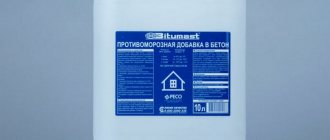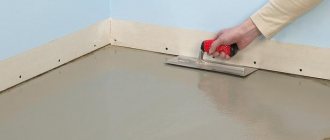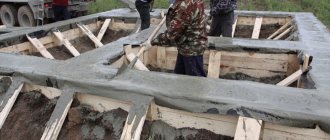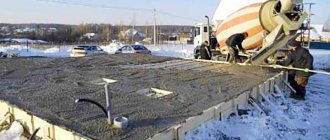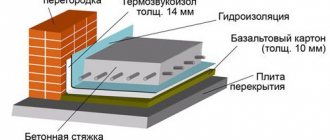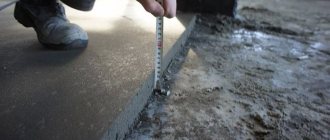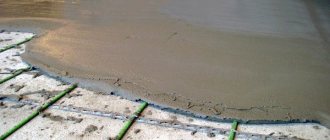The question of how long concrete takes to dry is of interest to any builder, since the duration of construction work depends on the time of setting and hardening of the mixture. Regardless of the type of object under construction, be it a temporary shed, a garage or a multi-story building, compliance with the hardening time allows you to create a structure that has standard strength parameters. If you know the exact curing time, you can competently plan construction processes and effectively optimize the construction time of buildings.
Stages of drying concrete mortar
Hardening of the solution occurs due to hydration, that is, a reaction that, after pouring, begins to occur between water and the binder components of the mixture. The essence of the chemical process is to convert the constituents of concrete into calcium hydrosilicate, which, after final drying, forms a monolithic base with high strength parameters.
To determine the time for complete hardening of concrete, it is important to understand that all reactions that occur in the composition are conditionally divided into two stages:
- Setting
occurs approximately an hour after mixing. During this period, the elements of the solution react, and the mixture itself begins to lose its mobile and plastic properties. - Hardening
- implies crystallization of the solution with a branded set of rigidity and strength. Hardening times depend on weather conditions, proportions and quality of the solution components.
Physical and chemical model of setting
From the point of view of physical processes, setting of M200 concrete is a process in which the static surface of Portland cement grains is coated with polyhedral crystals (calcium aluminate). The number of crystals grows exponentially, forming a single crystal lattice. Strong spatial connections arise between grains of Portland cement.
The chemical setting process is based on the initiation of several reactions:
- 3CaO*Al2O3+6H2O -> 3CaO*Al2O3*6H2O - transformation of aluminum salts into hydroaluminates;
- Ca2SiO4+H2O -> Ca2SiO4*H2O - transformation of calcium salts into hydrocalcinates;
- 3CaO*SiO2+H2O -> 3Ca2SiO4*H2O+Ca(OH)2 - transformation of silicate salts into hydrosilicates.
The reactions are accompanied by the release of heat. Approximately 60% water participates in chemical reactions. The remaining 40% remains in the closed cells of the concrete mass, forming its porous structure.
How long does it take for concrete to set?
The setting stage of the solution lasts a short time. On average, for the most popular brands (M200, M300) it does not exceed 1 hour at a temperature of +20°C. If the temperature is lower, the time increases to 4–5 hours, and in hot weather, coupling may take no more than 20–30 minutes.
Builders need to take into account the hardening time of concrete, since the finished solution very quickly loses its plasticity. To avoid possible problems in the future, use the prepared mixture immediately after mixing. Often it is delivered to the construction site ready-made in special concrete mixers, which do not stop mixing even during transportation.
Hardening processes
Hardening is a longer process, lasting on average up to 28 days. Immediately after setting, the solution still remains soft, but already becomes immobile. Gradually it undergoes crystallization and acquires the necessary rigidity indicators. The strength gain is determined according to the graph or using the formula:
Rn = R28(lgn/lg28), where:
- Rn – solution strength;
- n – time that has passed since pouring the mixture (in days);
- R28 – brand of building material.
Strength parameters are determined only from the third day from the moment of mixing. When figuring out how long concrete hardens, special attention is paid to the 7th and 28th days. On average, after 14 days from filling, Rn reaches 70%.
Stages of composition readiness
The process of solidification of the foundation and composition is conventionally divided into several stages. A detailed study of the process allows you to accurately determine how long the foundation hardens in a particular case.
The main concept is that the concrete mixture does not dry out in the classical sense of the word, but undergoes a chemical reaction process, as a result of which it acquires the specified characteristics.
In the first 24 hours after pouring into a mold (formwork), concrete gains about 30% of its design strength. After 3 days - about 50%, and after 7 days - up to 70% of the projected value. During observations, it was found that it takes 28 days (4 weeks) for the material to completely harden.
When selecting concrete for building a house, attention is paid to such parameters as the grade of concrete, the date of packaging and storage conditions. The material manufacturer also plays a role.
In order for the foundation to withstand the processes of soil heaving in winter, it is laid below the freezing level. This requires a larger volume of concrete, but passing the freezing depth is a mandatory parameter during foundation work.
Freezing depth
The air temperature when working with concrete should be at least 5 degrees Celsius. When the temperature drops below this level, artificial heating must be used. All builders strive to further influence the mixture in order to achieve the required level faster and continue the construction of the building.
Temperature
The optimal temperature for drying the solution is +20…+22°C. The higher it is, the faster the mixture sets and hardens. If the thermometer reads 0°C or below, hydration stops. In such a situation, builders have to use artificial hardening methods, for example, adding potassium chloride or turning on heat guns. In extreme heat, it is necessary to increase the humidity of the concrete, otherwise the moisture from the mixture will quickly evaporate and, as a result, a chemical reaction will not begin.
To figure out how long it takes for a concrete screed to dry outside at different temperatures, check out the table.
| Solution temperature, °C | Hardening time, days | ||||
| 3 | 5 | 7 | 14 | 28 | |
| 50 | 70 | 84 | 95 | – | – |
| 40 | 64 | 75 | 85 | – | – |
| 30 | 57 | 68 | 76 | 95 | – |
| 20 | 50 | 60 | 69 | 87 | – |
| 10 | 42 | 51 | 59 | 75 | 91 |
| 0 | 31 | 39 | 46 | 61 | 77 |
Concrete grade
The process of setting and hardening is largely influenced by the components of the mixture and their proportions. In particular, the more porous materials in the solution, the slower the evaporation of moisture will be. The main factor in the hydration time is the grade of concrete. The lower it is, the less intense the strength gain of the building material. Although heavier grades harden faster, in any case it is recommended to keep the finished solution for at least 28 days before loading.
Let's look at how long it takes for the most popular brands of concrete to harden.
| Brand | Brand strength, % | Maximum strength, kgf/cm² | Curing time, days |
| M400 | 100 | 196,45 | 25 |
| M300 | 60 | 360,18 | 14 |
| M200 | 30 | 392,9 | 3 |
Additives to concrete to increase strength
If work is carried out in conditions of too high or too low temperatures, it is necessary to use additives to harden the concrete, reduce or increase the setting speed, increase ductility and impart other properties. To ensure high quality concrete in winter, it is necessary to maintain optimal temperature and humidity conditions using electric heating, steam heating and the installation of a “thermos”.
Types of additives:
- antifreeze - reduces the freezing point of a liquid, increases adhesion, does not cause corrosion of fittings, is safe for people, used in an amount of 1%–2% depending on the air temperature;
- sulfates - accelerate the hardening of concrete due to the active release of heat; during mixing, the components are evenly distributed;
- concrete hardening accelerators - help to better dissolve the silicate components of cement, which, when hydrated, form salts that reduce the freezing point of water.
Antifreeze additives
These additives increase the liquid phase, during which the process of hydration and maturation of the material occurs. If the water in the pores freezes, the chemical reactions of combining cement with water will not proceed as expected, and after thawing, the components will crumble instead of combining into stone. It must be taken into account that the strength gain of concrete with antifreeze additives occurs more slowly compared to the hardening rate under normal conditions. Strength before freezing is 30% of the declared strength, the remaining 70% is gained by the material after thawing.
The choice of antifreeze additives and the quantity depend on the type of structure, the degree of reinforcement, the degree of aggressiveness of the environment, the presence of stray currents, and air temperature, since some types lead to corrosion of metal elements, a decrease in the adhesion strength of concrete to reinforcement, and the appearance of efflorescence on the surface.
Modifiers
Modifiers are used when it is necessary to increase strength by 1-2 grades, durability, resistance to low or high temperatures, and chemicals. They reduce the permeability of concrete and improve the mobility of the solution at the pouring stage. Thanks to them, it lays evenly, penetrating into all the cracks and recesses. For different buildings and structures they use their own modifiers - some for wells and pools, and others for facades or floor screeds.
Plasticizers
Plasticizers impart plasticity to the solution, increase mobility, adhesion, and liquefy, without reducing the setting speed and strength. Additives reduce the amount of water, which increases density, frost resistance, and reduces shrinkage deformations. Additives allow you to fill hard-to-reach places with concrete mixture when pouring complex structures. They are introduced at 0.1–1.2% of the total volume of the mixture. Their validity period is 2–3 hours.
What does a violation of exposure time lead to?
Builders are advised to fully maintain the drying time of the mortar. If you put stress on it ahead of schedule, this can lead to a number of problems in the future:
- The appearance of cracks
- this is especially true for the foundations of buildings, which can be subject to fracture along the entire height. Often cracks appear not only in the foundation, but also in the ceilings or walls, and they are often through. To avoid troubles with the foundation, it is important to know how long concrete hardens in the ground. As a rule, the formwork is removed no less than 2 weeks after it is poured, otherwise the structure may be damaged. - Deformation
– common problems associated with insufficient concrete curing time include deformation processes in the foundation, cracking of the floor screed, and the formation of chips or dents on the walls. - Damage to finishing
- occurs after interior or exterior finishing work. For example, if a house was built from unseasoned aerated concrete, then plaster may fall off the walls or wallpaper may peel off. If the floor screed in the bathroom does not have enough time to harden, ceramic tiles may subsequently peel off from it.
Maintaining mix strength
In order for concrete to be stronger, it must dry evenly throughout its entire volume, so structures must be constantly wetted over the entire surface.
In order for the chemical reaction inside the solution to take place, a liquid is necessary, because setting occurs thanks to water. But since hardening as a process lasts more than one day, the water can simply evaporate. To prevent this from happening, the surface of the structure must be watered and then covered with film or roofing felt. Concrete needs to be moistened constantly, especially during the hot and dry seasons. If the weather is windy, the corners and surface of the exposed base will dry faster than the rest of the interior. But for concrete to be stronger, it must dry evenly throughout its entire volume.
It should be remembered that concrete during the hardening process changes its volume and shrinks. Shrinkage occurs faster in the surface layers of the base. If you do not provide it with a sufficient amount of water, shrinkage cracks will form on the surface, the appearance of which will reduce the strength and durability of the structure.
In industrial construction, a concrete structure is constantly heated during its maturation. Private owners are advised not to pour concrete in cold weather.
In the cold season, it is not advisable to pour the concrete foundation of your own house or any buildings on your personal plot. This is due to the fact that the water contained in the solution can simply freeze. Freezing, it will increase in volume and begin to destroy concrete from the inside, and its hardening will stop. If the air temperature is below 10 degrees, the hardening process will proceed very slowly. In industrial construction, a concrete structure is constantly heated during its maturation, so work on pouring foundations can be carried out at any time of the year. But private owners are recommended to build a foundation only in the summer when the air temperature is plus 20 degrees and above.
How to speed up the drying of the mixture
If construction deadlines are tight, that is, it is not possible to wait for final hardening or it is not possible to ensure optimal humidity and temperature, it is permissible to use methods that help speed up hardening. These include:
- heating the solution at low air temperatures (steam, electricity, etc.);
- the use of additives to accelerate hardening;
- laying polyethylene on the surface, which retains the heat generated during hydration.
Carrying out construction work using concrete requires a special approach at each stage. If you approach the drying time of the mixture correctly, you can achieve increased strength of the building and avoid troubles associated with its deformation due to insufficient curing.
Author of the article
Effect on adhesion
To obtain an optimal rate of setting of the material, additives are introduced into its composition, along with the main components of concrete: accelerators and retarders. The use of additives is regulated by GOST 24211-2008.
Accelerators speed up the setting speed of M200 grade by 20-30%. The simplest and most inexpensive accelerator is calcium chloride. Retarders are used to reduce the setting speed, for example, when performing monolithic work in the heat. Popular moderators are nitrilotrimethylenephosphonic acid and sodium citrate. Thanks to the use of additives, the setting time of B15 concrete can be predicted with an accuracy of 90%.
